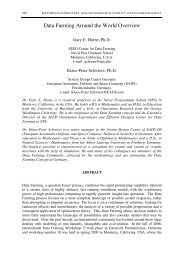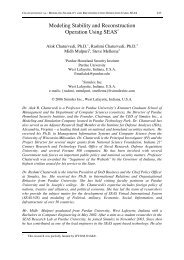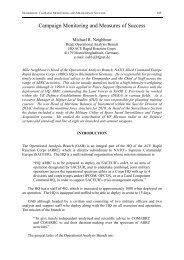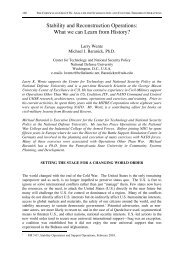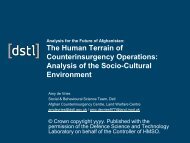The British Army's Effectiveness in the Irish ... - Cornwallis Group
The British Army's Effectiveness in the Irish ... - Cornwallis Group
The British Army's Effectiveness in the Irish ... - Cornwallis Group
Create successful ePaper yourself
Turn your PDF publications into a flip-book with our unique Google optimized e-Paper software.
102 THE CORNWALLIS GROUP XIV: ANALYSIS OF SOCIETAL CONFLICT AND COUNTER-INSURGENCY<br />
Previous <strong>Cornwallis</strong> <strong>Group</strong> proceed<strong>in</strong>gs have described how <strong>the</strong> use of Systems<br />
Dynamics techniques are useful for <strong>the</strong> study of counter<strong>in</strong>surgency campaigns. Edward<br />
Anderson from <strong>the</strong> University of Texas has published a number of papers on this subject,<br />
us<strong>in</strong>g <strong>the</strong> <strong>Irish</strong> Campaign as a case study. 52 Validat<strong>in</strong>g such a model presents challenges as<br />
<strong>the</strong> IRA campaign was highly regional, a factor that caused cont<strong>in</strong>ual frustration to <strong>the</strong> IRA<br />
Chief of Staff <strong>in</strong> Dubl<strong>in</strong>. Even with<strong>in</strong> an <strong>Irish</strong> county, <strong>the</strong>re could be wide variation between<br />
<strong>the</strong> commitment of units to <strong>the</strong> cause. 53 Never<strong>the</strong>less, Anderson’s approach is an important<br />
step for <strong>the</strong> professional OR community. A commercial games company has announced it<br />
will release a manual wargame <strong>in</strong> 2009 known as ‘Black and Tan.’ 54 Thus <strong>the</strong> ‘amateur’ OR<br />
practitioners, perhaps those who saw <strong>the</strong> film <strong>The</strong> W<strong>in</strong>d That Shakes <strong>the</strong> Barley can also<br />
beg<strong>in</strong> to understand some of <strong>the</strong> dynamics of this highly-<strong>in</strong>fluential but somewhat forgotten<br />
campaign.<br />
SUMMARY<br />
<strong>The</strong> <strong>British</strong> fought a campaign whose objectives were unclear from <strong>the</strong> beg<strong>in</strong>n<strong>in</strong>g and where<br />
policy was split between Dubl<strong>in</strong> and London and made more <strong>in</strong>efficient by separate and<br />
sometimes <strong>in</strong>dependent command and control of <strong>the</strong> security forces. To <strong>the</strong>ir surprise, <strong>the</strong><br />
army’s Great War technological sophistication and combat experience was of little help <strong>in</strong><br />
Ireland. Imperial overstretch, ironically to countries such as Iraq and Afghanistan, meant that<br />
<strong>the</strong> military forces deployed to Ireland were <strong>in</strong>adequate for <strong>the</strong> task <strong>in</strong> numbers and tra<strong>in</strong><strong>in</strong>g.<br />
<strong>The</strong> creation of paramilitary police, largely under separate command and control<br />
arrangements, to fill this gap <strong>in</strong> <strong>the</strong> security forces became disastrous when a reprisals policy,<br />
<strong>in</strong> lieu of proper polic<strong>in</strong>g methods, brought <strong>in</strong>ternational opprobrium and alienated <strong>the</strong> police<br />
from <strong>the</strong> public. Any guerrilla warfare experience from <strong>the</strong> Boer War had long been<br />
forgotten. <strong>The</strong> problems of <strong>in</strong>telligence meant that force could not be targeted and <strong>the</strong><br />
<strong>in</strong>evitable excesses fuelled <strong>the</strong> S<strong>in</strong>n Fe<strong>in</strong> propaganda mach<strong>in</strong>e. However, <strong>in</strong> early 1920 and<br />
<strong>the</strong>n a year later, <strong>the</strong> army appeared to be on top of <strong>the</strong> situation. A fresh deployment of<br />
troops, which was threatened by <strong>the</strong> <strong>British</strong> team negotiat<strong>in</strong>g <strong>the</strong> Treaty <strong>in</strong> 1921, may have<br />
defeated <strong>the</strong> IRA, but by now <strong>the</strong> S<strong>in</strong>n Fe<strong>in</strong> movement was unstoppable. <strong>The</strong> opportunity to<br />
avoid war was lost 6 years earlier, with <strong>the</strong> heavy-handed response to Easter and <strong>the</strong> dilatory<br />
approach to <strong>the</strong> <strong>in</strong>troduction of Home Rule.<br />
Despite lack<strong>in</strong>g arms and tra<strong>in</strong><strong>in</strong>g, <strong>the</strong> <strong>Irish</strong> revolutionaries were not to be dealt with as<br />
easily as <strong>in</strong> previous <strong>in</strong>surrections. A discipl<strong>in</strong>ed movement with efficient <strong>in</strong>telligence and<br />
counter-<strong>in</strong>telligence elements, it proved itself resilient although arguably it was on its last<br />
legs <strong>in</strong> most of <strong>the</strong> country, except for a few areas such as Cork which offered stubborn<br />
resistance. <strong>The</strong> guerrilla campaign was conducted alongside a political movement with an<br />
effective propaganda arm, which was particularly <strong>in</strong>fluential <strong>in</strong> <strong>the</strong> United States. <strong>The</strong> S<strong>in</strong>n<br />
Fe<strong>in</strong> movement had widespread active public support and where it was not active, <strong>the</strong>re was<br />
at least acquiescence that it was worth putt<strong>in</strong>g up with <strong>the</strong> hardships, <strong>in</strong>clud<strong>in</strong>g <strong>the</strong> <strong>British</strong><br />
reprisals. Martyrdom, which seems to have been a desired outcome of <strong>the</strong> 1916 rebellion,<br />
cont<strong>in</strong>ued <strong>in</strong> <strong>the</strong> form of hunger strikes that put enormous pressure on <strong>the</strong> <strong>British</strong> to grant<br />
52 Edward G Anderson Jr, ‘A Prelim<strong>in</strong>ary Systems Dynamics Model of Insurgency Management: <strong>The</strong> Anglo-<br />
<strong>Irish</strong> War of 1916-21 as a Case Study.’ Paper presented at <strong>the</strong> 2006 International Systems Dynamics<br />
Conference, Nijmegen, Ne<strong>the</strong>rlands.<br />
53 S<strong>in</strong>ead Joy, <strong>The</strong> IRA <strong>in</strong> Kerry 1916-1921 (Cork: <strong>The</strong> Coll<strong>in</strong>s Press, 2005), 78-93.<br />
54 http://files.boardgamegeek.com/file/download/3oomt3hez7/B_T_WIP05_2008.pdf



